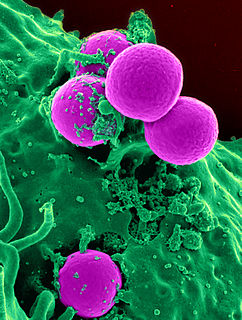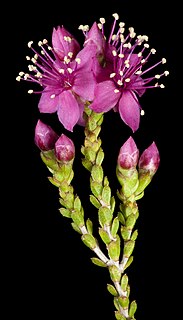
Staphylococcus aureus is a Gram-positive, round-shaped bacterium a member of the Firmicutes, and is a usual member of the microbiota of the body, frequently found in the upper respiratory tract and on the skin. It is often positive for catalase and nitrate reduction and is a facultative anaerobe that can grow without the need for oxygen. Although S. aureus usually acts as a commensal of the human microbiota it can also become an opportunistic pathogen, being a common cause of skin infections including abscesses, respiratory infections such as sinusitis, and food poisoning. Pathogenic strains often promote infections by producing virulence factors such as potent protein toxins, and the expression of a cell-surface protein that binds and inactivates antibodies. The emergence of antibiotic-resistant strains of S. aureus such as methicillin-resistant S. aureus (MRSA) is a worldwide problem in clinical medicine. Despite much research and development, no vaccine for S. aureus has been approved.

Methicillin-resistant Staphylococcus aureus (MRSA) refers to a group of Gram-positive bacteria that are genetically distinct from other strains of Staphylococcus aureus. MRSA is responsible for several difficult-to-treat infections in humans. MRSA is any strain of S. aureus that has developed or acquired a multiple drug resistance to beta-lactam antibiotics. Beta-lactam (β-lactam) antibiotics are a broad-spectrum group that include some penams and cephems such as the cephalosporins. Strains unable to resist these antibiotics are classified as methicillin-susceptible S. aureus, or MSSA.
Lecithinase is a type of phospholipase that acts upon lecithin.
Tefibazumab is a humanized monoclonal antibody for the treatment of severe infections with Staphylococcus aureus. Possible indications include the treatment of S. aureus in a phase 2a patients with cystic fibrosis and of methicillin-resistant S. aureus.

The ring-tailed cardinalfish is a widespread fish species in the family Apogonidae found in the Red Sea and off East Africa to Papua New Guinea, north to Japan, and south to Australia.

The golden-backed bishop is a species of bird in the family Ploceidae. It is found in western Angola and São Tomé Island.
'Staphylococcus aureus delta toxin is a toxin produced by Staphylococcus aureus. It has a wide spectrum of cytolytic activity.

Amblyglyphidodon aureus also known as the golden damselfish is a species of marine fish in the family Pomacentridae, the damselfishes and clownfishes. It is native to the central Indo-Pacific.

Chamelaucieae is a tribe of flowering plants within the family Myrtaceae, mostly from Australia, with a few species in New Caledonia and south-east Asia.

Staphylococcus is a genus of Gram-positive bacteria in the family Staphylococcaceae from the order Bacillales. Under the microscope, they appear spherical (cocci), and form in grape-like clusters. Staphylococcus species are facultative anaerobic organisms.

Homalocalyx is a genus of shrubs in the family Myrtaceae described as a genus in 1857. The entire genus is endemic to Australia.
Homalocalyx chapmanii is a member of the family Myrtaceae endemic to Western Australia.
Homalocalyx coarctatus is a member of the family Myrtaceae endemic to Western Australia.
Homalocalyx echinulatus is a member of the family Myrtaceae endemic to Western Australia.
Homalocalyx ericaeus is a member of the family Myrtaceae endemic to Western Australia.
Homalocalyx grandiflorus is a member of the family Myrtaceae endemic to Western Australia.
Homalocalyx inerrabundus is a member of the family Myrtaceae endemic to Western Australia.
Homalocalyx pulcherrimus is a member of the family Myrtaceae endemic to Western Australia.
Homalocalyx staminosus is a member of the family Myrtaceae endemic to Western Australia.

Homalocalyx thryptomenoides is a member of the family Myrtaceae endemic to Western Australia.







